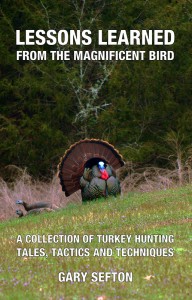By Gary Sefton
The real thrill, the glamor and the mystique that make turkey hunting such a fascinating endeavor is calling. Translating the sounds into understandable terms, then imitating them with man-made devices to communicate with a different species in their own language is what calling is all about. Not only communicating but using their language to manipulate them to an advantageous position. In my opinion, calling is the soul, the spirit and the essence of turkey hunting.
The trick to calling anything is in knowing what to say, when to say it, and what the call should sound like. Once you have that information, you will need an accurate device to reproduce the sounds.
YELPS, KEE-KEES and KEE-KEE RUNS
The most widely used vocalization in turkey talk, the one I consider to be the cornerstone of the turkey language, is a two-note sound called the yelp. It is used by hens and gobblers in varying degrees of volume, intensity and duration to send different signals. When you dissect a yelp, you find that it is made up of a high pitched “kee” note that breaks over very sharply into a sound best described as a “youck”. When you put the two sounds together you get a “kee-youck”, which is about as close as I can come to describing the yelp sound with words. You should be familiar with all of the yelp sequences so you will be sure you are sending the right message at the right time. We will talk about all of them, beginning with the young poult’s earliest attempt to communicate.
The first note in the yelp is the whistle sound called a “kee”. When turkeys are very young, they can manage the first half of the yelp, so the first calling sound they make is a plain kee-kee or poult whistle. The young turkey’s lost calls are plaintive and pleading and as pure and clear as a silver bell. I don’t get to hear poult whistles very often, but when I stumble into a brood while berry picking or working up food plots, I stop whatever I’m doing and enjoy the music. Young poult whistles are far and away the most musical bird calls I’ve ever heard. The whistles are usually done in groups of three – kee-kee-kee, kee-kee-kee – and repeated every 30 seconds or so until contact is made with the family flock.
When the poults get a little older, their whistle gets a little coarser and the young turkeys start trying to add a “youck” syllable to the “kee” to make a complete yelp. The young hens whistle two or three times to build up a yelp, then they yelp a time or two. When they are able to get that done, the sequence is called a “kee-kee run”, for whatever reason. Young gobblers sometimes gargle out an attempt at a yelp before they whistle, then yelp two or three times after the whistle.
As the turkeys mature, they usually drop the pre-yelp whistles altogether, but turkeys can do whatever they want to do so it isn’t unusual to hear adult hens doing kee-kee runs in the spring.
If you do any fall hunting, the kee-kee run is a must-learn call since it is the poult’s lost call and the one they are most likely to respond to. I have also been successful using kee-kee runs in the spring. On several occasions I have been able to get gobblers to respond to kee-kees when they wouldn’t gobble at any of my counterfeit calls or even the yelping of a genuine hen. I don’t believe they gobble at the kee-kees because they are pedophiles. I believe the kee-kees are such pure, unadulterated turkey sounds they penetrate whatever kind of B.S. filter the turkey might have, and they gobble whether they want to or not. If turkeys aren’t talking, a kee-kee run is worth a try. You won’t alarm anything, and you just might get something stirred up.
This article is based on information from Lesson 1 in “Lessons Learned From The Magnificent Bird”, a turkey hunting book written by Gary Sefton. To know more about turkey calling techniques, what to say and how to say it, plus 16 more turkey hunting lessons, check out the book here. While you’re here, check out other titles in the “On Target” series of how-to books published by Target Communications Outdoor Books. You can also find more how-to articles on a range of topics in the How-To section. Ordering details will direct you to PayPal or to the publisher’s order department.


